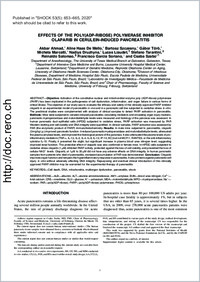Effects of the poly(ADP-ribose) polymerase inhibitor olaparib in cerulein-induced pancreatitis
- Ahmad, Akbar Department of Anesthesiology, The University of Texas Medical Branch at Galveston, Galveston, Texas
- Haas De Mello, Aline Department of Anesthesiology, The University of Texas Medical Branch at Galveston, Galveston, Texas
- Szczesny, Bartosz Department of Anesthesiology, The University of Texas Medical Branch at Galveston, Galveston, Texas
- Törö, Gábor Department of Anesthesiology, The University of Texas Medical Branch at Galveston, Galveston, Texas
- Marcatti, Michela Department of Anesthesiology, The University of Texas Medical Branch at Galveston, Galveston, Texas
- Druzhyna, Nadiya Department of Anesthesiology, The University of Texas Medical Branch at Galveston, Galveston, Texas
- Liaudet, Lucas Department of Intensive Care Medicine and Burns, Lausanne University Hospital Medical Center, Lausanne, Switzerland
- Tarantini, Stefano Department of Geriatric Medicine, Reynolds Oklahoma Center on Aging, University of Oklahoma Health Sciences Center, Oklahoma City, Oklahoma
- Salomao, Reinaldo Division of Infectious Diseases, Department of Medicine, Hospital São Paulo, Escola Paulista de Medicina, Universidade Federal de São Paulo, São Paulo, Brazil
- Garcia Soriano, Francisco Laboratório de Investigação Médica—Faculdade de Medicina da Universidade de São Paulo, São Paulo, Brazil
- Szabo, Csaba Department of Anesthesiology, The University of Texas Medical Branch at Galveston, Galveston, Texas - Chair of Pharmacology, Faculty of Science and Medicine, University of Fribourg, Fribourg, Switzerland
-
26.06.2020
Published in:
- Shock. - 2020, vol. 53, no. 5, p. 653–665
English
Objective: Activation of the constitutive nuclear and mitochondrial enzyme poly (ADP- ribose) polymerase (PARP) has been implicated in the pathogenesis of cell dysfunction, inflammation, and organ failure in various forms of critical illness. The objective of our study was to evaluate the efficacy and safety of the clinically approved PARP inhibitor olaparib in an experimental model of pancreatitis in vivo and in a pancreatic cell line subjected to oxidative stress in vitro. The preclinical studies were complemented with analysis of clinical samples to detect PARP activation in pancreatitis.Methods: Mice were subjected to cerulein-induced pancreatitis; circulating mediators and circulating organ injury markers; pancreatic myeloperoxidase and malondialdehyde levels were measured and histology of the pancreas was assessed. In human pancreatic duct epithelial cells (HPDE) subjected to oxidative stress, PARP activation was measured by PAR Western blotting and cell viability and DNA integrity were quantified. In clinical samples, PARP activation was assessed by PAR (the enzymatic product of PARP) immunohistochemistry.Results: In male mice subjected to pancreatitis, olaparib (3 mg/kg i.p.) improved pancreatic function: it reduced pancreatic myeloperoxidase and malondialdehyde levels, attenuated the plasma amylase levels, and improved the histological picture of the pancreas. It also attenuated the plasma levels of pro-inflammatory mediators (TNF-α, IL-1β, IL-2, IL-4, IL-6, IL-12, IP-10, KC) but not MCP-1, RANTES, or the anti-inflammatory cytokine IL- 10. Finally, it prevented the slight, but significant increase in plasma blood urea nitrogen level, suggesting improved renal function. The protective effect of olaparib was also confirmed in female mice. In HPDE cells subjected to oxidative stress olaparib (1 μM) inhibited PARP activity, protected against the loss of cell viability, and prevented the loss of cellular NAD+ levels. Olaparib, at 1μM to 30 μM did not have any adverse effects on DNA integrity. In human pancreatic samples from patients who died of pancreatitis, increased accumulation of PAR was demonstrated.Conclusion: Olaparib improves organ function and tempers the hyperinflammatory response in pancreatitis. It also protects against pancreatic cell injury in vitro without adversely affecting DNA integrity. Repurposing and eventual clinical introduction of this clinically approved PARP inhibitor may be warranted for the experimental therapy of pancreatitis.
- Faculty
- Faculté des sciences et de médecine
- Department
- Médecine 3ème année
- Language
-
- English
- Classification
- Biological sciences
- License
- License undefined
- Identifiers
-
- RERO DOC 329906
- DOI 10.1097/SHK.0000000000001402
- Persistent URL
- https://folia.unifr.ch/unifr/documents/309152
Statistics
Document views: 94
File downloads:
- sza_epp.pdf: 285
